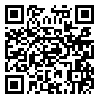Volume 28, Issue 112 (12-2019)
JGUMS 2019, 28(112): 31-47 |
Back to browse issues page
Download citation:
BibTeX | RIS | EndNote | Medlars | ProCite | Reference Manager | RefWorks
Send citation to:



BibTeX | RIS | EndNote | Medlars | ProCite | Reference Manager | RefWorks
Send citation to:
Vaezi S K, Mehrabian F, Shafieepour M. Designing a Model for Estimating the Value of Human Assets, based on the Non-monetary Valuation Approach in Guilan University of Medical Sciences. JGUMS 2019; 28 (112) :31-47
URL: http://journal.gums.ac.ir/article-1-2225-en.html
URL: http://journal.gums.ac.ir/article-1-2225-en.html
Abstract: (2742 Views)
Abstract
Introduction: The ability to record the value of human assets in a financial statement is one of the requirements of modern human resource management.
Objective: Design a model for estimating the value of human assets using a non-monetary valuation approach in Guilan University of Medical Sciences and prioritizing its indicators.
Materials and Methods: The research method was combination type. Dimensions and components that affect the assessment of human asset value were extracted from library studies and research background. Semi-structured interviews with 45 teachers and senior managers of the university were done by Purposeful Judgment (theoretical) sampling. Qualitative analysis of interview data was performed by content analysis method and categorization of indices with open and axial and selected coding. Distributing the questionnaire and collecting the comments of 376 university staff and conducting exploratory and confirmatory factor and hierarchical analysis were carried out.
Results: A model of assessment human asset value was presented with 5 dimensions including: ability dimension with knowledge, leadership, skill, innovation components and performance dimension with the components of productivity, participation, commitment and potential dimension with education, talent components and attitude dimension with humility, organizational commitment, honesty, job satisfaction, balance of work and life, organizational identity components, organizational climate dimension with technological readiness, organizational culture, and human resource priorities components.
Conclusion: The results showed that the components of honesty, leadership, priority of human resources, individual productivity and ability dimension among the five dimensions had the highest priority in the sample.
Conflict of interest: non declared
Introduction: The ability to record the value of human assets in a financial statement is one of the requirements of modern human resource management.
Objective: Design a model for estimating the value of human assets using a non-monetary valuation approach in Guilan University of Medical Sciences and prioritizing its indicators.
Materials and Methods: The research method was combination type. Dimensions and components that affect the assessment of human asset value were extracted from library studies and research background. Semi-structured interviews with 45 teachers and senior managers of the university were done by Purposeful Judgment (theoretical) sampling. Qualitative analysis of interview data was performed by content analysis method and categorization of indices with open and axial and selected coding. Distributing the questionnaire and collecting the comments of 376 university staff and conducting exploratory and confirmatory factor and hierarchical analysis were carried out.
Results: A model of assessment human asset value was presented with 5 dimensions including: ability dimension with knowledge, leadership, skill, innovation components and performance dimension with the components of productivity, participation, commitment and potential dimension with education, talent components and attitude dimension with humility, organizational commitment, honesty, job satisfaction, balance of work and life, organizational identity components, organizational climate dimension with technological readiness, organizational culture, and human resource priorities components.
Conclusion: The results showed that the components of honesty, leadership, priority of human resources, individual productivity and ability dimension among the five dimensions had the highest priority in the sample.
Conflict of interest: non declared
Review Paper: Research |
Subject:
Special
Received: 2020/01/14 | Accepted: 2020/01/14 | Published: 2020/01/14
Received: 2020/01/14 | Accepted: 2020/01/14 | Published: 2020/01/14
| Rights and permissions | |
 |
This work is licensed under a Creative Commons Attribution-NonCommercial 4.0 International License. |







